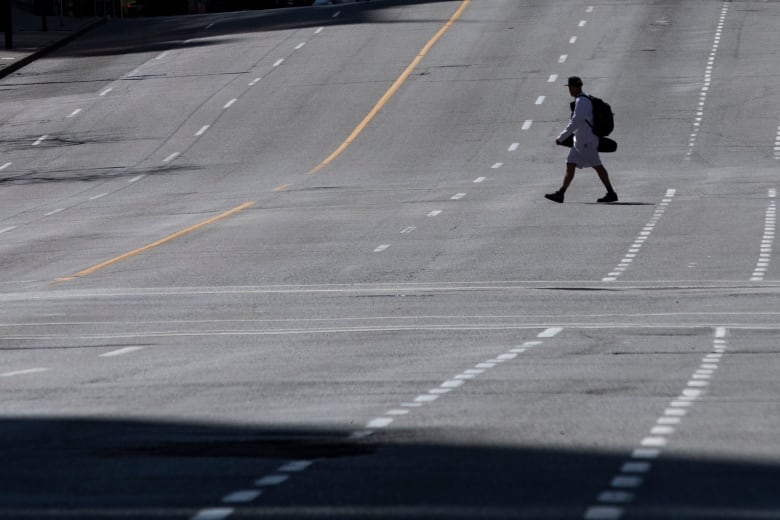Cleaner air during pandemic lockdowns shows what’s possible, say researchers
Roughly one year ago, city streets across Canada were deserted.
There were virtually no cars, no trucks and few buses as the country went into lockdown mode. Shops and buildings were closed. Most people stopped commuting. And it was the same across most of the world.
While millions of lives have been lost due to COVID-19, and people have suffered economic consequences, these short-term global shutdowns have had a marked effect on the environment.
The amount of pollutants that were pumped into the atmosphere dropped noticeably — including in southern Ontario, where a recent study documented a 20 per cent drop of some pollutants compared to recent years.
And that, in turn, has positive effects on our health, something researchers in the field hope won’t soon be forgotten as life creeps back to normal.

Bad air kills
It’s estimated that each year roughly 8.7 million people around the world die from conditions attributed to air pollution from fossil fuels. And that’s due to pollutants like nitrogen dioxide (NO2), ozone and PM 2.5 (a type of fine particulate matter that can be inhaled) that is produced by cars, industry, coal-fired power plants and other sources.

Studies have also shown that people in countries with elevated levels of air pollution were more susceptible to COVID-19.
“The Harvard School of Public Health found that there was an 11 per cent increase in mortality for [even a small] increase in different air pollution components,” said Dr. Courtney Howard, who works in Yellowknife and was the past president of the Canadian Association of Physicians for the Environment.
Previous work has already shown greater risk from respiratory disease in places with higher levels of air pollution in China and Europe.
“It just makes sense,” said Howard. “If somebody’s body is already struggling to try to cope with the effects of air pollution and there’s been some lung damage and some increased levels of inflammation already in their body, that another stressor would be more difficult for those people to contend with.”
Cleaner air without lockdowns?
A recent study published in the Journal of Hazardous Materials quantified the effects of the lockdown on air in southern Ontario, one of the most densely populated regions in Canada.
Researchers used 16 ground-based sites across the region and found that, from April to December 2020, carbon monoxide (CO) and NO2 pollutant levels dropped 20 per cent compared to the three previous years. In some locations there was also a decrease in ozone and PM 2.5, however, the researchers said that it was not considered to be a statistically significant drop.
It’s a good reminder of what’s possible. We’ve seen how clear the skies can get.– Jeff Brook, University of Toronto air quality researcher
While the lockdowns were a drastic measure to help stop the spread of COVID-19, better planning and guidelines could be used to help reduce pollutants and their respective health effects.
“I hope that the public and different levels of government will use our study as a benchmark for their future measures or regulations, either to limit the spread of new diseases or to control air pollution and smog episodes,” said Hind Al-Abadleh, a chemistry professor at Wilfrid Laurier University and lead author of the paper.

“These pollutants contribute to air pollution and to respiratory diseases. Canada is known to have faster growing rates of childhood asthma among the countries around the world.”
The significant drop of air pollutants such as NO2, is something that researchers hope can continue after the lockdown, but with less drastic measures.
Jeff Brook, an assistant professor at University of Toronto’s Dalla Lana School of Public Health, studies air quality. The former senior research scientist at Environment and Climate Change Canada is creating a web-based app that will allow people to check on the air quality wherever they are in Canada.
“All we know about air pollution and health relationships suggests that any improvement leads to benefits in health,” Brook said. “What COVID is showing … is that the moment that the lockdown started, we saw bigger gains or equal gains as to what we achieved over 10 years of efforts.”
“It’s a good reminder of what’s possible. We’ve seen how clear the skies can get. We’ve seen how people can change their habits to some extent.”
Howard said that she hopes that the COVID-19 pandemic illustrates what humanity can do when it comes to the environment.
“It’s a moment of crisis, but it’s also a moment of opportunity,” Howard said. “And we can move forward from here in a way that’s going to make a better world.”
www.cbc.ca 2021-03-13 09:00:00


